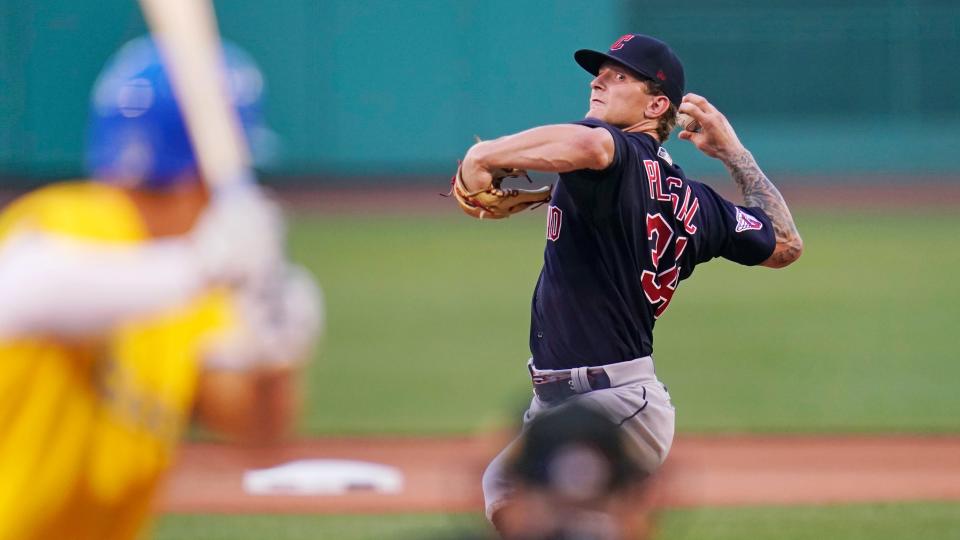What is Fielding Independent Pitching (FIP) and why is it important to know?

The baseball world has undergone a revolution over the last few decades, and it has transformed how many view the game.
And although no metric can completely quantify the game as a whole, those in and around baseball now have better ways to break down what's happening and what might happen next.
In addition to batting average, RBIs, pitcher wins and ERA, some advanced metrics — fWAR, wRC+, BABIP, FIP, OOA, wOBA and so many others — give us a more complete picture of what's going on or why something happened. It isn't just to replace the "eye test" or scouting, but it is to be layered on top of everything else, sort of like a blueprint.
And why is it so important for these metrics to appear in our coverage? That's simple: because teams are using advanced metrics as a part of their decision-making, whether it comes to player evaluation as a whole, free agency, trade decisions, the draft, anything and everything. And since teams have rolled analytical ways of evaluating players into their decision-making, it is imperative that the coverage of those teams reflect that. Otherwise, readers and listeners are being left out on key aspects that evaluate how teams are operating in this modern age of baseball.
News:Guardians trade catcher Sandy Leon to Twins for pitcher Ian Hamilton
NewsTwo home runs enough for Blue Jays to defeat Triston McKenzie, Guardians
Some readers have sent emails asking for explanations of some of these advanced numbers in an effort to better understand them, so we thought we'd offer some explainers to give extra context. And in the future, whenever these metrics are used in stories, these explainers will be linked and readily available for a refresher.
Here are the primers on Wins Above Replacement, weighted runs created plus and ERA+.
Up next: Fielding Independent Pitching (FIP).
What is Fielding Independent Pitching (FIP)?
Fielding Independent Pitching (FIP) sort of works like the more common Earned Run Average (ERA), but FIP aims to measure what a pitcher's ERA should look like if he were to experience league average results on balls in play. In effect, FIP is trying to take the "luck" factor out of ERA and focus more on the results a pitcher can control: strikeouts, walks and home runs.
Balls in play can be finicky to measure, since a bloop can land for a hit and a hard-hit line drive can result in a highlight-reel catch. FIP aims to take some of that luck — meaning the variables of the defensive play by infielders and outfielders — out of the equation to better show a pitcher's actual performance over a given period of time. One pitcher's ERA could be helped by having a great defense behind him while another could be hurt by a poor defense. In this way, FIP can be a better measurement, in general, of pitcher performance.
To put it in fewer words: FIP values the outcomes a pitcher can control, with everything else (balls put into play) being league average for everybody. In that way, FIP acts as a better indicator of how a pitcher as actually performed separate from simply looking at results from the box score. As with everything, FIP cannot tell the whole story. But it is a slightly better version of ERA that adds a bit more context.
News:Cal Quantrill, Josh Naylor lead streaking Cleveland Guardians over Toronto Blue Jays
The formula for FIP is adjusted so that the league average ERA and league average FIP are the same. This makes it easier to compare the two figures. Just like with ERA, a 3.00 FIP would be terrific. a 4.00 FIP would be closer to average. Anything approaching a 5.00 FIP would be considered below league average or, if even higher, poor.
FIP can also be a better indicator of future performance than ERA. Since ERA's formula leaves more room for variance and luck, how a pitcher actually performed with a certain ERA can be cloudier or noisier.
News:Guardians playoff odds reach highest point of 2022 with 9-2 record in extra-inning games
Former Cleveland reliever Dan Otero is a great example of this. In 2015, Otero's last season with the Oakland A's, he had a dreadful 6.75 ERA in 46⅔ innings, but his FIP that season was 4.40 — much lower. That still isn't a great FIP, but it was one indicator that Otero wasn't nearly as bad as his ERA would suggest.
Cleveland acquired Otero in a low-risk deal due to these advanced metrics thinking it was worth it to take a flier on him and possibly find some value despite his high ERA the year prior. The belief was that he wasn't nearly as poor as his ERA, and it wouldn't cost much to acquire him (he was selected off waivers by the Philadelphia Phillies and then acquired by Cleveland for only cash considerations). Otero went on to give Cleveland two great seasons — which included a middle relief role during the 2016 run to the World Series — and two average years (2018, 2019) at a low cost, which vital for many teams.
Ryan Lewis can be reached at rlewis@thebeaconjournal.com. Read more about the Guardians at www.beaconjournal.com/sports/cleveland-guardians. Follow him on Twitter at @ByRyanLewis.
This article originally appeared on Akron Beacon Journal: What to know about Fielding Independent Pitching (FIP) metric in MLB
